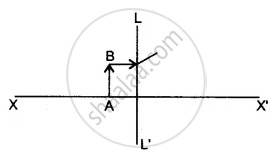Advertisements
Advertisements
प्रश्न
What is the focal length of a convex lens of focal length 30 cm in contact with a concave lens of focal length 20 cm? Is the system a converging or a diverging lens? Ignore thickness of the lenses.
उत्तर
Focal length of the convex lens, f1 = 30 cm
Focal length of the concave lens, f2 = −20 cm
Focal length of the system of lenses = f
The equivalent focal length of a system of two lenses in contact is given as:
`1/"f" = 1/"f"_1 + 1/"f"_2`
`1/"f" = 1/30 - 1/20`
`1/"f" = (2 - 3)/60`
`1/"f" = -1/60`
∴ f = −60 cm
Hence, the focal length of the combination of lenses is 60 cm. The negative sign indicates that the system of lenses acts as a diverging lens.
APPEARS IN
संबंधित प्रश्न
Define the power of a lens.
Find the focal length of a lens of power −2.0 D. What type of lens is this?
The lens A has a focal length of 25 cm whereas another lens B has a focal length of 60 cm. Giving reason state, which lens has more power: A or B.
Name the physical quantity whose unit is dioptre.
Which of the two has a greater power: a lens of short focal length or a lens of large focal length?
What is the power of a convex lens lens whose focal length is 80 cm?
What is the nature of a lens having a power of + 0.5 D?
Fill in the following blank with suitable words :
The reciprocal of the focal length in metres gives you the _________ of the lens, which is measured in ___________.
An object of height 4 cm is placed at a distance of 15 cm in front of a concave lens of power, −10 dioptres. Find the size of the image.
A convex lens of power 5 D and a concave lens of power 7.5 D are placed in contact with each other. What is the :
(a) power of this combination of lenses?
(b) focal length of this combination of lenses?
Name the type of lens whose power is positive.
The image of an object formed by a lens is real, inverted and of the same size as the object. If the image is at a distance of 40 cm from the lens, what is the nature and power of the lens ? Draw ray diagram to justify your answer.
Find the radius of curvature of the convex surface of a plano-convex lens, whose focal length is 0.3 m and the refractive index of the material of the lens is 1.5.
A screen is placed a distance 40 cm away from an illuminated object. A converging lens is placed between the source and the screen and its is attempted to form the image of the source on the screen. If no position could be found, the focal length of the lens
A pin of length 2.00 cm is placed perpendicular to the principal axis of a converging lens. An inverted image of size 1.00 cm is formed at a distance of 40.0 cm from the pin. Find the focal length of the lens and its distance from the pin.
Complete the diagram to show the formation of the image of the object AB.

(i) Name the Lens LL’.
(ii) Where is the image of the object AB formed?
(iii) State three characteristics of the image.
If focal length of a convex lens is 20 cm at what is the power of the lens?
Increase in the converging power of eye lens cause ‘hypermetropia'
Define power of a lens. What is its unit? One student uses a lens of focal length 50 cm and another of –50 cm. What is the nature of the lens and its power used by each of them?
The focal length of a concave lens is 20 cm. The focal length of a convex lens is 25 cm. These two are placed in contact with each other. What is the power of the combination? Is it diverging, converging or undeviating in nature?
The same size images are formed by a convex lens when the object is placed at 20 cm or at 10 cm from the lens. The focal length of convex lens is ______ cm.
